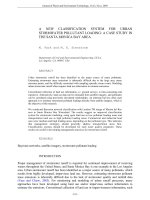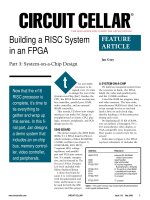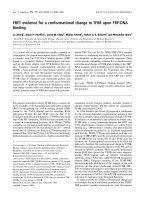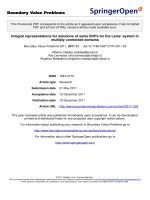DIGITAL TWINDRIVEN SIMULATION FOR A CYBERPHYSICAL SYSTEM IN INDUSTRY 4.0
Bạn đang xem bản rút gọn của tài liệu. Xem và tải ngay bản đầy đủ của tài liệu tại đây (364 KB, 8 trang )
DAAAM INTERNATIONAL SCIENTIFIC BOOK 2017
pp. 227-234
Chapter 18
DIGITAL TWIN-DRIVEN SIMULATION FOR A
CYBER-PHYSICAL SYSTEM IN INDUSTRY 4.0
YANG, W.; TAN, Y.; YOSHIDA, K. & TAKAKUWA, S.
Abstract: Nowadays, digital twin technology enables autonomous objects to mirror
the current state of processes and their own behaviour in interaction with the
environment in the real word. Cyber-physical systems (CPS) are increasingly
communicating with each other and with human participants in real time via the
Internet of things. This study focuses on attaining digital twin-driven simulation and
implement simulation experiments with real-time data. Using a distributed model
equipped with sensor as the physical system, a simulation model is constructed to
reflect the physical system and simulation experiments are carried out. The proposed
modelling method can be further applied in the simulation-based support tools for
decision-making with real-time data.
Key words: Digital Twin, Industry 4.0, Physical/Cyber Space, Simulation
Authors´ data: Assist. Prof. Yang, W[enhe]*; Asso. Prof. Tan, Y[ifei]**; Yoshida,
K[ohtaroh]*; Prof. Takakuwa, S[oemon]*, *Chuo University, 1-13-27 Kasuga,
Bunkyo-ku, Tokyo, 112-8551, JAPAN, **Chuo Gakuin University, 451 Kujike,
Abiko, Chiba, 270-1196, JAPAN, , ,
,
This Publication has to be referred as: Yang, W[enhe]; Tan, Y[ifei]; Yoshida,
K[ohtaroh] & Takakuwa, S[oemon] (2017). Digital Twin-Driven Simulation for a
Cyber-Physical System in Industry 4.0 Era, Chapter 18 in DAAAM International
Scientific Book 2017, pp.227-234, B. Katalinic (Ed.), Published by DAAAM
International, ISBN 978-3-902734-12-9, ISSN 1726-9687, Vienna, Austria
DOI: 10.2507/daaam.scibook.2017.18
Yang, W.; Tan, Y.; Yoshida, K. & Takakuwa, S.: Digital Twin-Driven Simulation f...
1. Introduction
The increasing customization of products will require dramatic changes in the
market, forcing manufacturing to cope with complex and uncertain situations with
flexibility and adaptability. In 2010, the German government initiated the concept of
“Industrie 4.0” to promote its economic development and pursue stronger global
competitiveness in manufacturing. The fourth industrial revolution (Industry 4.0) is
now a collective term for a number of technologies involving automation, data
exchange, and manufacturing that include cyber-physical systems (CPS), the Internet
of things (IoT), and cloud computing (Kukushkin et al., 2016; Takakuwa, 2016).
CPS refers to a new generation of systems with integrated computational and
physical capabilities that can interact with each other and with humans in real time over
new modalities (Baheti & Gill, 2011). Digital twin technology is a methodology that
enables autonomous objects (products, machines, etc.) to link the current state of their
processes and behaviour in interaction with the environment of the real world. In this
manner, manufactured products could increasingly employ converged cyber-physical
data to become smart products that incorporate self-management capabilities based on
connectivity and computing technology. Under data twinning, manufacturing
machines become software- enhanced machinery equipped with sensors and actuators
with computing power that can respond quickly to uncertain situations (Almada-Lobo,
2015). Furthermore, Simulation is a thoroughly proven approach to analysing system
behaviour and design, which can conduct numerical experiments at a low cost. As a
fidelity simulation method, digital twin can be used not only during system design but
also during runtime to predict system behaviour online (Gabor et al., 2016).
The topics of CPS and digital twin have received increasing attention from
researchers in recent years. Lee et al. (2015) defined a five-level (Connection,
Conversion, Cyber, Cognition, Configure) architecture for CPS. Gabor et al. (2016)
presented an architectural framework centred on the information flow within a CPS
that incorporates a digital twin. Uhlemann et al. (2017) presented an approach to
demonstrate the potential for real-time data acquisition using a digital twin concept.
Most of these studies focused on the modelling concepts and framework of a CPS
digital twin.
The goal of this study was to build a simulation model to reflect a physical system
and then to use the resulting digital twin system to carry out experiments in the runtime.
2. Digital Twin
The digital twin paradigm has been applied in the NASA U.S. Air Force Vehicles
project (Boschert & Rosen, 2016), where it was defined as,
“ A Digital Twin is an integrated multiphysics, multiscale, probabilistic
simulation of an as-built vehicle or system that uses the best available physical models,
sensor updates, fleet history, etc., to mirror the life of its corresponding flying twin.”
The digital twin concept model contains three primary components (Grieves,
2014):
DAAAM INTERNATIONAL SCIENTIFIC BOOK 2017
pp. 227-234
Chapter 18
1) A physical object in real space;
2) A virtual object in virtual space;
3) Data and information connections that converge the physical and virtual systems.
The characteristics of a digital twin can be summarized as real-time situation
reflection, physical/ cyber convergence and interaction, and self-evolution. In the
manufacturing field, sensor-equipped machines could collect data in real-time from the
production system. By connecting physical and cyberspace, the digital twin would
reflect the system’s real state. By updating data in real time, the model can undergo
continuous improvement by comparing cyber space with physical space in parallel
(Boschert & Rosen, 2016; Tao et al. 2017).
3. Modelling Framework
The composition and modelling framework of a CPS are shown in Fig. 1. The
system comprises physical space, cyber space, and connected data that tie the two
together.
Physical Space
Cyber Space
Real Time
Data
Sensor
Simulation
Product
Machine
Process
...
Digital
Twin
Optimization
Quick
Response
Fig. 1. Composition and the modelling framework of the CPS.
Based on the digital twin concept, sensor and data communication technology is
employed to update the twin of the physical system in real time and the real-time data
of an object in the physical space is transmitted to a constructed cyber simulation model
to obtain linkage between cyber and physical space.
On the other hand, with the collected real-time and historical data, statistical
analysis, intelligent system evaluating, forecasting and decision-making support can be
performed online in the real time.
4. Simulation
4.1 Physical System
This section illustrates an example of a real physical system that was modelled
based on digital twin concept. For this purpose, a distributed model called a mini-
Yang, W.; Tan, Y.; Yoshida, K. & Takakuwa, S.: Digital Twin-Driven Simulation f...
vehicle system was used as the physical system object in the study. An image of the
distributed system is shown in Fig. 2. The mini-vehicle is driven by dry battery and
controlled by an on/off switch; as long as the switch is turned “on,” the vehicle
continues to run until the battery runs down. In this manner, the mini-vehicle model
can be seen to represent a flow production line, with the defined position (as illustrated
in Fig. 2) assumed to represent a processing point.
Vehicle
Defined
Point
Route
Fig. 2. Image of the distributed model.
In the study, a light sensor (peak wavelength 540 nm ***) was set at the position
of the defined point shown in Fig. 2. The sensor generates an output signal (0/1)
indicating the intensity of light. To acquire real-time data from system, a simple
shading item was tied to the left side of the vehicle. The signal was set to turn to one
when the received light wavelength was less than 100 nm and to remain at zero
otherwise. In this manner, a changed signal could be sent by the sensor when the
vehicle passed the defined point.
Furthermore, an Excel VBA program was developed to record the times at which
the sensor single turned to one, i.e., the times at which the vehicle passed the defined
point. The time difference between each succeeding one signal could therefore be
defined as the system cycle time, allowing real-time data from physical system to be
recorded in the cyber system (in this case, i.e., in a Microsoft Excel Workbook).
To constructing the simulation model, two main objectives were as follows:
1) To reflect the physical system’s real situation for the purpose of using sensing data;
2) To experimentally assess the ability of the twin model to use real-time and
historical data.
4.2 Digital Twin-driven Simulation
1) Simulation Model
To achieve the first objective above, a simulation model to reflect a real
distributed model was constructed. The model was developed using the simulation
DAAAM INTERNATIONAL SCIENTIFIC BOOK 2017
pp. 227-234
Chapter 18
software Arena. The main parameter used in the model is the system cycle time, which
is defined as a route time required for the entity to travel through the defined point.
Additionally, the ReadWrite module was used to import the real-time cycle time
from Microsoft Excel into the Arena model.
2) Improved Model
To achieve the second objective, the simulation model was improved with the
following procedures: Firstly, a VBA input interface was developed to define a lap
number that implement the experiment. Subsequently, run the simulation model. The
model reads the cycle time data acquired from the sensor, which exactly like the
processes discussed in the 4.1, until the defined number of laps is reached. From the
(defined number+1) th lap, the cycle time of the model was generated randomly based
on the average and standard deviation of the historical data. An Excel VBA program
was designed to control the model. The logic procedure of the program is shown in
Fig. 3.
Physical Space
Run
Physical System
Cyber Space
Define the lap number to implementing
experiment
Lap number = Lap number + 1
Data
Feedback
Lap number=defined lap
number+1
Feedback
Yes
Database
Data
Data
No
Read the real-time
data
Generate data based on the
average and standard deviation
of the historical data
Feedback
Write the output data in the
Excel Book
Terminating
Condition
End
Fig. 3. Logic procedure of the VBA program.
By combining the simulation capabilities of Arena and VBA via the sensor data,
a customized integrated simulation model could be constructed that is both dynamic
and flexible.
4.3 Experiments
Simulation Experiments were designed to demonstrate that the model can reflect
the system’s real state and implement run time experiments using historical data.
In this case, the lap number to generate cycle time based on the historical data was
set to 30. A screen shot of the simulation model in the run mode is shown in Fig. 4. A
Yang, W.; Tan, Y.; Yoshida, K. & Takakuwa, S.: Digital Twin-Driven Simulation f...
partial output data example of the model is shown in Tab. 1. There are five columns in
the Tab. 1. Column A shows the times at which the vehicle passes the defined point, as
recorded automatically by light sensor. Column B shows the difference (millisecond)
between the time in column A and 0:00:00 of that day. Column C shows the cycle time
calculated from the differences between the adjacent rows in column B. Column D
shows the model input data using as the vehicle route time. Moreover, Column E shows
the output of the cycle time written by the simulation while the model is running.
Fig. 4. A screen shot of the simulation model.
As shown in Tab. 1, the output cycle time from 1st to defined (30th) laps is the
same with the sensor tracking data in the real-world system, which proved that the
simulation model reflects the physical system real situation correctly. Whereas, cycle
time from the 31st lap is not equal to the corresponding real data from physical space.
The model uses an estimated cycle time based on historical data, which shows that the
simulation experiments can be carried out successfully in the run-time.
5. Conclusion
Under the Industry 4.0 environment, physical space can be connected with cyber
space via IoT. A digital twin-driven model was developed as a preliminary study, using
a distributed model equipped with sensors as a physical system. It was found that the
model could reflect real situation of the physical system with the real-time data. In
addition, experiments were executed to evaluate the system performance in terms of
its ability to simulate run-times in the real system.
The proposed modelling method for capturing real-time data together with
simulation experiments can be further applied in the implementation of simulationbased support tools. The resultant insights can be referenced for better decision-making
on the corresponding physical system. The distributed model used in the study was a
rather simple system; further studies will be performed for actual manufacturing
systems.
DAAAM INTERNATIONAL SCIENTIFIC BOOK 2017
A
B
C
pp. 227-234
D
Chapter 18
E
1
2
3
4
5
6
7
8
9
10
11
12
14:24:38.570
51878.57
6.13
6.13
6.13
14:24:44.700
51884.7
6.09
6.09
6.09
14:24:50.790
51890.79
6.02
6.02
6.02
14:24:56.810
51896.81
6.05
6.05
6.05
14:25:02.860
51902.86
6.04
6.04
6.04
14:25:08.900
51908.9
6.16
6.16
6.16
14:25:15.060
51915.06
6.10
6.10
6.10
14:25:21.160
51921.16
6.08
6.08
6.08
14:25:27.240
51927.24
6.16
6.16
6.16
14:25:33.410
51933.41
6.18
6.18
6.18
14:25:39.580
51939.58
6.16
6.16
6.16
14:25:45.740
51945.74
6.26
6.26
6.26
24
25
26
27
28
29
30
31
32
33
34
35
36
14:26:59.840
52019.84
6.05
6.05
6.05
14:27:05.900
52025.9
6.22
6.22
6.22
14:27:12.120
52032.12
6.18
6.18
6.18
14:27:18.300
52038.3
6.16
6.16
6.16
14:27:24.460
52044.46
6.18
6.18
6.18
14:27:30.640
52050.64
6.18
6.18
6.18
14:27:36.820
52056.82
6.21
6.21
6.21
14:27:43.020
52063.02
6.12
6.15
6.15
14:27:49.140
52069.14
6.16
6.23
6.23
14:27:55.300
52075.3
6.15
6.22
6.22
14:28:01.450
52081.45
6.11
6.07
6.07
14:28:07.560
52087.56
6.10
6.20
6.20
14:28:13.660
52093.66
6.16
6.04
6.04
45
46
47
48
49
50
14:29:08.560
52148.56
6.05
6.13
6.13
14:29:14.610
52154.61
6.08
6.07
6.07
14:29:20.700
52160.7
6.05
6.18
6.18
14:29:26.750
52166.75
5.98
6.18
6.18
14:29:32.730
52172.73
6.02
6.23
6.23
14:29:38.750
52178.75
6.04
6.16
6.16
Tab. 1. Partial data example from the experiment.
Yang, W.; Tan, Y.; Yoshida, K. & Takakuwa, S.: Digital Twin-Driven Simulation f...
6. Acknowledgements
This research was supported by Chuo University. Yang W. was supported by
JSPS KAKENHI Grant Number JP17K12984.
7. References
Almada-Lobo, F. (2015). The Industry 4.0 revolution and the future of Manufacturing
Execution Systems (MES). Journal of Innovation Management, Vol.3, No.4, pp. 1621, 2183-0606
Baheti, R. & Gill, H. (2011). Cyber-physical systems, The Impact of Control
Technology, pp. 161-166, 0018-9162
Boschert, S. & Rosen, R. (2016). Digital twin - the simulation aspect, In: Mechatronic
Futures - Challenges and Solutions for Mechatronic Systems and their Designers,
Hehenberger, P. & Bradley, D., (Ed.), pp. 59-74, Springer International Publishing,
978-3-319-32154-7, Switzerland
Gabor, T.; Belzner, L.; Kiermeier, M.; Beck, M. T. & Neitz, A. (2016). A simulationbased architecture for smart cyber-physical systems. Proceedings of 2016 IEEE
International Conference on Autonomic Computing, Kounev, S.; Giese, H. & Liu, J.
(Ed.), pp. 374-379, 978-1-5090-1654-9, Wurzburg, Germany, July 2016, Conference
Publishing Services, Washington
Grieves, M. (2014). Digital twin: manufacturing excellence through virtual factory
replication, Available from: />0_Digital_Twin_White_Paper_Dr_Grieves.pdf Accessed: 2017-9-8
Kukushkin, I.; Zavrazhina, A.; Grabenweger, J.; Kildibekov, A.; Katalinic, B. &
Haskovic, D. (2016). Model-based concept for scheduling analysis of packaging lines,
Proceedings of the 26th DAAAM International Symposium,B. Katalinic (Ed.),
pp.1149-1157, 978-3-902734-07-5, DAAAM International, Vienna, Austria
Lee, J.; Bagheri, B. & Kao, H.-A. (2015). A cyber-physical systems architecture for
Industry 4.0-based manufacturing systems. Manufacturing Letters, Vol 3, pp. 18-23,
2213-8463
Takakuwa, S. (2016). Operations management of shop floor in the Industry 4.0
environment. Proceedings of Asia Pacific Conference on Information Management
2016, Sato, O.; Minh, N. D.; Jung, C. Y. & Mao, J. (Ed.), pp. 251-260, 978-604-626481-1, Hanoi, Vietnam, October 2016, Vietnam National University Press, Hanoi
Tao, F.; Cheng, Q.; Qi, M.; Zhang, H. & Sui, F. (2017). Digital twin-driven product
design, manufacturing and service with big data. Available from:
Accessed: 2017-9-8
Uhlemann, T. H.-J.; Schock, C.; Lehmann, C.; Freiberger, S. & Steinhilper, R. (2017).
The digital twin: demonstrating the potential of real time data acquisition in production
systems. Procedia Manufacturing, Vol 9, pp. 113-120, 2351-9789
*** - GROVE light sensor v1.2, Accessed: 2017-9-8









